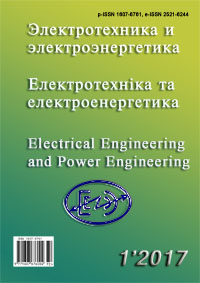THE STUDY OF THE SPECTRAL RELATIONSHIP OF THE DIELECTRIC PERMITTIVITY OF POLAR DIELECTRICS IN THE LOW FREQUENCY RANGE
DOI:
https://doi.org/10.15588/1607-6761-2017-1-1Keywords:
spectral depandence, dielectric permittivity, polar dielectrics, the low-frequency rangeAbstract
The purpose of the work. Research of the spectral depandence of the dielectric permittivity of polar dielectrics with different degree of packing of the crystal structure in the low frequency range.Research methods. To obtain the spectral depandence of the dielectric permittivity of polar dielectrics used method of determining the capacitance of the capacitor, between the plates which are placed the sample under study. According to the received capacity value of the capacitor calculated value of the dielectric constant of the sample.
The results obtained. The authors obtained spectral depandence of the dielectric permittivity of dielectric materials with different degree of packing of the crystal lattice. Mathematical processing of the obtained experimental results allowed to establishing the linear character of the spectral depandence in logarithmic coordinates. Based on this proposed a power function adequately describing the spectral depandence of the dielectric permittivity of polar dielectrics at low frequencies.
Scientific novelty. The authors numerically determined power-law coefficient α, which depends on the nature of the dielectric and it can be regarded as a criterion of the packing density of the crystal lattice of the polar dielectrics.
Practical significance. The research results can be used to study the mechanism of polarization of polar dielectrics, used in electrical products under the influence of alternating electric fields of different frequencies.
References
Maljushevs’ka, A. P., Toporov, S. O. (2016). Vpliv skladu і morfologії kondensatornih polіmernih plіvok na termostabіl’nіst’ їh korotkochasnoї elektrichnoї mіcnostіka, Jelektrotehnika i jelektrojenergetika, 1, 18–24. DOI: http://dx.doi.org/10.15588/1607-6761-2016-1-3
Maljushevs’ka, A. P., Dmitrіshin, O. Ja., Toporov, S. O. (2015). Doslіdzhennja vplivu pіdvishhenih temperatur na ekspluatacіjnі vlastivostі transformatornogo masla T-1500 v plіvkovih ekspluatacіjnih sistemah. Jelektrotehnika i jelektrojenergetika, 2015, 1, 18–24. DOI: http://dx.doi.org/10.15588/1607-6761-2015-1-3
Tareev, B. M. (1982). Fizika dijelektricheskih materialov. Moscow, Jenergoizdat, 320.
Poplavko, Ju. M. (1980). Fizika dijelektrikov. Kiev, Vishha shkola, 400.
Rez, I. S., Poplavko, Ju. M. (1989). Dijelektriki. Osnovnye svojstva i primenenie v jelektronike. Moscow, Radio i svjaz’, 288.
Gusev, Ju. A. (2008). Osnovy dijelektricheskoj spektroskopii: ucheb. Posobie. Kazan’: Kazan. gos. un-t, 112.
Aleksandrov, K. S., Beznosikov, B. V. (2004). Perovskity, nastojashhee i budushhee. Novosibirsk: Izd-vo Sib. Otd-nie RAN, 230.
Bell, A. J. (2008) Ferroelectrics: The role of ceramic Sci. and engineering. Ceraam, Soc, 28, 1307–1317.
Jejzenberg, D., Kacman, V. (1975). Struktura i svojstva vody. Sankt-Peterburg, Gidroieteoizdat, 280 s.
Doronin, Ju. P. (2010). Fizika okeana. Sankt-Pеterburg, Gidrometeoizdat, 274.
Tonkonogov, M. P. (1998). Dijelektricheskaja spektroskopija kristallov s vodorodnymi svjazjami. Protonnaja relaksacija, UFN, 168, 1, 29–54.
Fesenko, E. G. (1972). Semejstvo perovskita i segnetojelektrichestvo. Moscow, Atomizdat, 248.
Galasso, F. S. (1969). Structure properties and Preparation of Perovskite-type Compounds / F/S/ Galasso-New York, Pergamon Press, 1969, 364.
Venevcov, Ju. N. (1968). Segnetojelektriki. Rostov-na-Don, Izd-vo Rost. Un-ta, 155.
Lajns, M., Glas, A. (1981). Segnetojelektriki i rodstvennye materialy. Moscow, Mir, 736.
Smolenskij, G. A., Bokov, V. A. (1985). Fizika segnetojelektricheskih javlenij. Isupov, Sankt-Pеterburg, Nauka, 396 .
Downloads
Published
How to Cite
Issue
Section
License
Copyright (c) 2017 A. I. Zolotarevskiy, S. P. Lushchin

This work is licensed under a Creative Commons Attribution 4.0 International License.
Creative Commons Licensing Notifications in the Copyright Notices
Authors who publish with this journal agree to the following terms:
Authors retain copyright and grant the journal right of first publication with the work simultaneously licensed under aCreative Commons Attribution License that allows others to share the work with an acknowledgement of the work's authorship and initial publication in this journal.
Authors are able to enter into separate, additional contractual arrangements for the non-exclusive distribution of the journal's published version of the work (e.g., post it to an institutional repository or publish it in a book), with an acknowledgement of its initial publication in this journal.
Authors are permitted and encouraged to post their work online (e.g., in institutional repositories or on their website) prior to and during the submission process, as it can lead to productive exchanges, as well as earlier and greater citation of published work.

